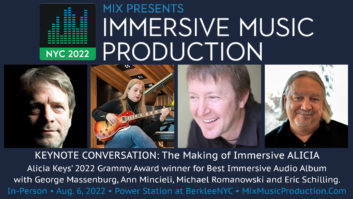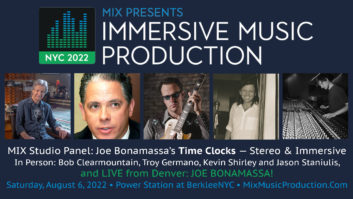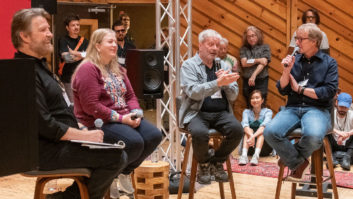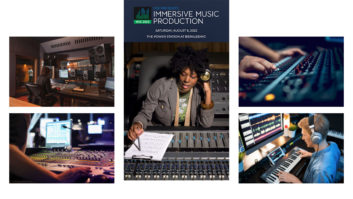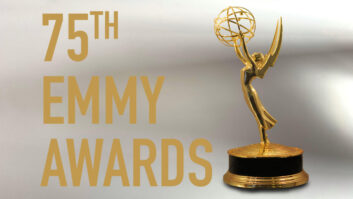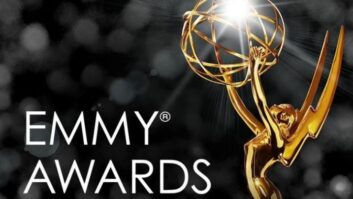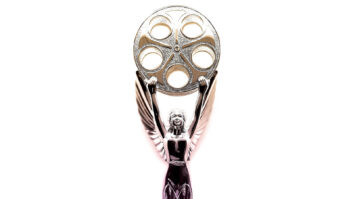Music has taken Kevin “Caveman” Shirley around the world and to the top of the charts. As a leading producer and mixer for more than a decade, he has worked with a succession of popular performers, including Aerosmith, Silverchair, Black Crowes, Little Steven, Dream Theater, Iron Maiden, Journey, Joe Satriani and more. In many ways, rock ‘n’ roll has been his salvation.
Born in Johannesburg, South Africa, to parents of Irish and English heritage, Shirley escaped the strict regimen of a conservative boarding school in Bloemfontein at age 13 by immersing himself in music. He steered clear of youth military exercises by playing drums in the marching band, then avoided that by playing French horn in the school orchestra, and by the time he was 15, he took command as conductor! “I wasn’t content with just being a performer,” he says. “So, I guess that’s where my musical aspirations began.”
After dodging the South African Defence Force by studying composition at the University of Capetown for 18 months, he found work as a sound engineer with the South African Broadcasting Corporation (SABC), doing pop and classical stuff. Then after that, he says, “I went traveling, running around Greece for six months, and then I came back and started working in studios.”
Shirley journeyed to Cape Town to work for producer Tully McCully at his Spaced Out Sound Studios, and quickly worked his way from second engineer to producing his own projects during studio downtime. The first one, Robin Auld’s At the Corner, was the first of four albums he would make with that artist, and that work resulted in Number One radio songs and Top 10 hits in South Africa. Shirley also worked with other local artists, including Juluka, Winston Mankunku and his own band, The Council. He even recorded a version of the South African black anthem, holed up in the studio with musicians fearing for their lives. Eventually, the oppressive apartheid system prompted his migration to Sydney, Australia.
While down under, Shirley connected with the group Baby Animals, whose demos generated interest from America. He went to L.A. with the band in 1990, and when they were signed to a major deal, their new producer, Mike Chapman, retained Shirley as an engineer. Following the multi-Platinum Baby Animals success, the duo went on to work together on albums by Material Issue and Billy Squier, among others. Then, Shirley hooked up with producer Peter Collins as an engineer on Rush’s Counterparts, two songs on Bon Jovi’s Greatest Hits and a Divinyls track for the Melrose Place soundtrack.
Shirley says he was “tired of being poor,” so he returned to Australia and landed the gig producing Silverchair’s multi-Platinum debut. It would prove to be a breakthrough, because when he returned to the States to drum up more business, A&R man John Kalodner hired him for projects he was working on at his new home, Columbia Records, including the Journey reunion album. After the successful Trial By Fire was released, Shirley’s stature grew, and this led to many higher-profile gigs.
Today, though Shirley’s name is associated with big-name artists, he also works with many new artists, including SoiL, Neurotica, Healing Sixes (with drummer Jason Bonham) and singer Tina Arena. He has also produced and/or engineered soundtrack cuts by Billy Joel, Oasis and Shawn Mullins, among others. We spoke to Shirley at his apartment in New York City last fall.
You’ve worked on a wide range of albums over the years. Have you developed certain sounds and spatial relationships that you like?
Those are things that you get an opinion about as you go on. If you listen to the Silverchair record I did, I’ve got the toms panned really hard left and right on that one. It sounded fine in the studio environment when I mixed it, but when I finally heard it on headphones, I was mortified. I thought it sounded so lame. So pretty much since then, most of my records have mono toms in them, except for Dream Theater. I always open them up, but he’s got 99 toms, so you get them spread. [Laughs.]
I really try not to impose on the music too much. I try to treat [the drum kit] like a single instrument. Give them their own space, as opposed to rack tom two being its own instrument and having its own space and own reverb. I think that I have unique approaches to some things. I think I have unique approaches to the way vocals sound. I don’t know what a lot of other people do, but I always think that my vocals sound more up-front than other people’s.
You obviously like analog. George Massenburg, the engineer for the Journey reunion album, said that it was nice to hear a real hi-hat after 15 years.
After George mixed the whole album, the band decided that they liked my mixes better, which is not a choice that I liked because George is one of my all-time heroes. I had a great time with him, and I love his work. But the band thought that I was more in tune with what they were trying to capture, so they went with my mixes — except for the single “When You Love a Woman,” which was a Number One song, we mixed together. That was a big honor for me to work with Massenburg.
What was it like working with Journey on Trial By Fire? They hadn’t worked together in 10 years.
It actually was a lot of fun. Before we started the record, their manager at the time, Michael Lippman, said we would be very lucky if we ever finished the record. And if I did finish it, it would probably take years and years. Before we started, I booked the mastering date four-and-a-half months down the stretch, and we made that mastering date. One of the key things in that was getting the pre-production right.
We initially started off on a two-week pre-production schedule, which I extended to six weeks. It didn’t go down very well with everybody, but the thing is they’d done all the demos pretty much in the way that they used to make records. They laid down the drum tracks, then laid the thing down. Some of the songs were built up on loops, and I had them learn the whole record. They could play the whole thing live by the time we went into the studio.
I tell you what, that band is fantastic. I’d be sitting in that room in San Francisco, and Journey would play this album for me every day for six weeks. It was a lot of work, but it was such a treat at the same time. They were magnificent musicians. The cool thing was when we got into the studio, they just played the songs. There was a lot less for me to do at that point than just wait for magic to happen. The song that was the biggest hit on there was all one take, including the guitar solo. You’ll hear the guitar starts when the solo kicks in — that’s Neal [Schon]. He stops playing rhythm, plays his solo, then goes back to playing rhythm. That’s the band playing. We later overdubbed an orchestra on it.
You also worked on the Iron Maiden reunion album, Brave New World. Singer Bruce Dickinson said that they had never recorded live in the studio and you encouraged them to do that.
And, to be honest, [bassist/group founder] Steve Harris was very resistant to that in the beginning. We set up in Paris at Guillaume Tell Studios, which is a great studio. They’d never recorded everybody playing at the same time. They’d always gone in and done the overdubs in the control room. I said, “Just try it, see how it goes.” The first day we were starting, Steve said, “I don’t think it’s going to work. We’ve never made records like this.” I said, “Well, let’s give it a go and see what happens.” We gave it a go, and he came back and said he was actually having a lot of fun.
Also, rehearsal was important. They had to be out of England for one reason or another, so they were holed up in France and were rehearsing and writing songs together. They weren’t all presented with the songs when they came into the studio. They had rehearsed and were ready to go.
What was the chemistry like with Journey and Iron Maiden, considering both classic line-ups had not played together in about a decade? Did you have to play the diplomat?
Always. For both of those bands. One of the amazing things is that you’ll often find that the best creative teams generally get out of the studio and diss each other terribly. It happens all the time and always has through history, from John and Paul to Roger Daltry and Pete Townsend, and Jimmy Page and Robert Plant.
Maiden had their idiosyncrasies. Steve Harris is the boss of the band. To his credit, he likes what he likes, and when he doesn’t like something, he just says, “I don’t like it.” And that’s it. I tried to fight some of those battles with Bruce.
Did you ever win any?
Oh, yeah. You have to pick your battles, though. Some of them you just let run their course, and when you think something’s really important, you have to stick by it. That’s what you do as a producer.
Have you ever had to tell somebody that their song sucked?
All the time.
How do you tell someone?
Exactly like that. I always work with the pretext that there is some merit to what they’ve written. Unfortunately, it’s not always true. The last Black Crowes album is a good example; the one Don Was produced [Lions], because they brought me all those same songs, and I didn’t think they were very strong. So, they just went to somebody who thought they were strong enough.
You recorded the new Iron Maiden live album from Rock In Rio in Brazil. There has got to be a lot of things that can go wrong when you have a crowd of 300,000 people and you’ve got wires everywhere.
Rock In Rio was a phenomenal show. We had so many amazing artists, and every night was a different genre of music. The night before the heavy metal night was the pop night with Britney Spears, ‘N Sync, all those kind of people. When they were packing up the bands at the end of the night, somebody drove one of the carts across the main snake, with all the power, all the cabling and all the speakers — everything between the front desk and the main stage. They cut through the entire cable and blew two-thirds of the P.A.
The worst time to do that!
That’s right, the night before the heavy metal gig. So we were all set to do a soundcheck, and they didn’t even have a link between the front of house and the stage, which they finally repaired in time, but they didn’t have parts. I don’t know if anybody knew — I certainly don’t think Maiden knew — but they were playing on a third of the P.A. rig.
Did you have people re-do parts on that album?
No, we didn’t re-do any parts. And, actually, there’s nothing re-done, and sometimes that’s not always the best thing. There are times when Bruce is right in front of the monitors, and you can’t hear him for the noise that’s coming through. He’s got a wireless microphone. At those points, in both the DVD and CD mix, I just let him blend into the thing. It’s part of what happens live. But the crowd was phenomenal.
One of the coolest things about playing there is that a South American crowd knows every single lyric of every single song. As soon as a couple of the first notes start, everyone sings. What used to be a problem with [playing to] 300,000 people, where you have all these delay towers all the way down the field, was that you’d have this long delay thing. So I just went into Pro Tools and found a snare crack on all the delay towers and shifted all the delay towers in time. All of a sudden, you have 300,000 people singing in time with the track, and it’s phenomenal. For the 5.1, it’s outrageous. The band barely features; the audience is just spine-tingling.
As far as technology, are you a Pro Tools man? Did you start off working in analog and shift to digital? Or do you use a mixture of the two?
I’m still in love with analog, and I still cut everything with analog. This band we’re cutting tomorrow — Cyde from Akron, Ohio — we’re cutting the whole thing on 15 ips, no-noise reduction, on 2-inch tape. Once I’ve got all the tracks, once I’ve got the beds, then I’ll put it into Pro Tools. We put the vocals straight into Pro Tools; I can pump up the vocals there and get the overdubs in there. You can’t make a record without Pro Tools now.
Do you prefer the quality of tracks on Pro Tools vs. 2-inch tape in terms of mixing?
I actually prefer mixing on Pro Tools, because there’s no degeneration of the tape. Although, I do love that initial tape compression and saturation [on analog]. Twenty-four-bit technology is definitely improving things a lot, and digital technology is getting better and better. It’s like listening to vinyl. It’s great on the virgin listen, but once the crackles and pops come in, it becomes a pain in the ass. If we can get the best of analog and then keep that in the digital domain, at least I know the sound is not going to change. I can go back on one part a hundred times if I have to, and I’m not going to have to gradually lift the high end because it’s being worn off the tape.
Do you have any favorite pieces of gear that you’ve grown fond of?
My favorite console is still the Neve 8068. I also love the SSL 9000 console. That’s just a fantastic tool. For a mixing console, the SSL 9000 is really unbeatable. It’s so versatile and so viable and sounds really good. My all-time favorite piece of gear has got to be the old UREI 1176 compressor.
As far as newer equipment that’s come in, I love this Roland VG-8 guitar synthesizer. That’s fantastic. I’ve used that for a while, and I’ve always introduced it to guys in the other bands, and they always say, “You’ll never see us touch them.” When we did the Aerosmith album, I showed Joe Perry my VG-8, which I put a little pick-up on one of my Strats. He was like, “Nah, I’ll never use that. If I use a 12-string, I’ll use a 12-string.” But if you see him live now, he’s got a VG-8 hooked up. I love that. And Neal Schon uses it. And this new band with Jason Bonham, Healing Sixes, uses it.
You’re selling the Healing Sixes CD on your Website. Are you trying to help them out?
Actually, no, I have a production deal with them. I paid for it. I spent $180,000 making the record with them. We just got a release with SPV in Europe for them, so that’s great. The record is great. Jason’s a great drummer.
You’ve worked with a lot of veteran bands with roots from the ’70s and ’80s. Is there a challenge in attempting to preserve their sound while modernizing it somewhat and making it accessible to a new audience?
With Aerosmith, I definitely tried to bridge the gap between the gloss pop of Get a Grip with [earlier albums like] Rocks and Toys. I tried to find a meeting ground for the two. [Nine Lives] came out pretty good. I was very happy with that record. It was a very tough record to make.
In what way?
It was very tough because they’d already made the record once and spent a lot of money with Glen Ballard in South Beach. To be honest, Steven [Tyler] had been very fond of the Alanis Morissette record, which Glen had produced, and Steven wanted to do a record pretty much in the same vein. A lot of the production that came out was not what anybody expected Aerosmith to be. I’m not saying that in a negative or a positive way, but suddenly Columbia just resigned them back from Geffen, and they had a sizable advance.
I can tell you that, from Tommy Mottola to Kalodner, nobody was happy with the record. And Joe Perry wasn’t happy with the record, and Brad [Whitford, rhythm guitarist] wasn’t happy with the record, and [drummer] Joey Kramer wasn’t playing on the record because his dad had died, and he had gone into his “blue funk period,” as he called it. So Steve Ferrone was playing on it, and he’s a great drummer, but it’s not Aerosmith; it really isn’t. I hate to say that. Joey has such a particular way that he drives the band. His hi-hat leads his snare drum, and it’s just the way he plays that you hear on every great Aerosmith track.
So did you re-record the same songs?
Yes.
Did you help re-arrange them?
Yes. When I first had my meeting with Steven and the guys, we initially talked about adding new guitars to the production that they had already done and really getting more of that “Joe Perry Rocks” side into the record. At the end of the day, everything was re-cut. It didn’t need to have been. I know there were some songs that Steven wanted to have carried over from the Glen Ballard sessions. Whether he likes to admit it or not, he had the choice to have them on.
I can tell you that the first masterings had different versions of the songs on, and he changed it all back to the versions that I produced by the time it came out. He definitely didn’t have to go with all of those versions, and quite honestly I think that it’s a good thing that they did, because those are all the Aerosmith versions. Whether or not the public was looking for a change, and would have accepted a change, in the Aerosmith sound is neither here nor there. My job was to make an Aerosmith album in a way that everybody from the people in the band to the management to the label thought that Aerosmith should sound.
So Joey came back and played?
Yeah. Then we cut them all the same way that I like to make a record, with everybody in the same room. That’s how I like to get the beds down, with everybody in so I can get some of the energy. And I can tell you it was some of the most exciting times. To be in the control room and have those guys jamming for 40 minutes — nothing in particular, just going out and playing together like I don’t think they had done for 20 years, with Steven making noises and playing harp and Joe soloing — was great! Brad is one of the most underrated guitar players in the world. For me, that was just phenomenal. That’s some of the power of the band right there, and so much of that just gets lost all of the time.
What’s the best album you’ve worked on?
That’s still to be made. My favorite album that I’ve worked on — well, there’s nothing like listening to Jimmy Page play. He’s my all-time favorite. That live album [with the Black Crowes] was just phenomenal. Jimmy is a wonderful, wonderful guy. I do not have enough nice words for Jimmy Page.
What would be the worst project you’ve ever done?
Oh, I’ve done so many of those. Not lately, though, because I’m also pig-headed about my hours now. I try and make myself excited every day to go to the studio. And I can be when I’ve had a good night’s sleep; I can’t be in the studio till midnight. So I like to work from noon till 9 o’clock, go and have some dinner, have a couple of drinks to chill out, come home, just watch the 11 o’clock news or something, and go to sleep. Maybe I’m getting old, but that’s what floats my boat right now.
It’s been so important. We start at noon every day, and that doesn’t mean we’re going to start with bagels and coffee. We’ll start playing at noon. We’ll have a downbeat at noon, then we’ll work for nine hours. We’re not going to eat during the day. We’ll stop and have a snack. We won’t screw around for 15 or 16 hours every day, because the next day you wake up and you feel tired. That’s awful to work like that, and it’s not very constructive.
If there’s one thing you’ve learned over the years, something valuable that you can pass on to people, what would it be?
You cannot forsake your home life. You have to try and be there for the people around you. Don’t make the studio the focus of everything, because you just end up shooting yourself in the foot. And you lose sight of the broader picture. Sometimes you’re much better when you’ve just been able to get away from it and think and let things fall into place and get some perspective.
Bryan Reesman is a freelance writer in the New York metro area.
